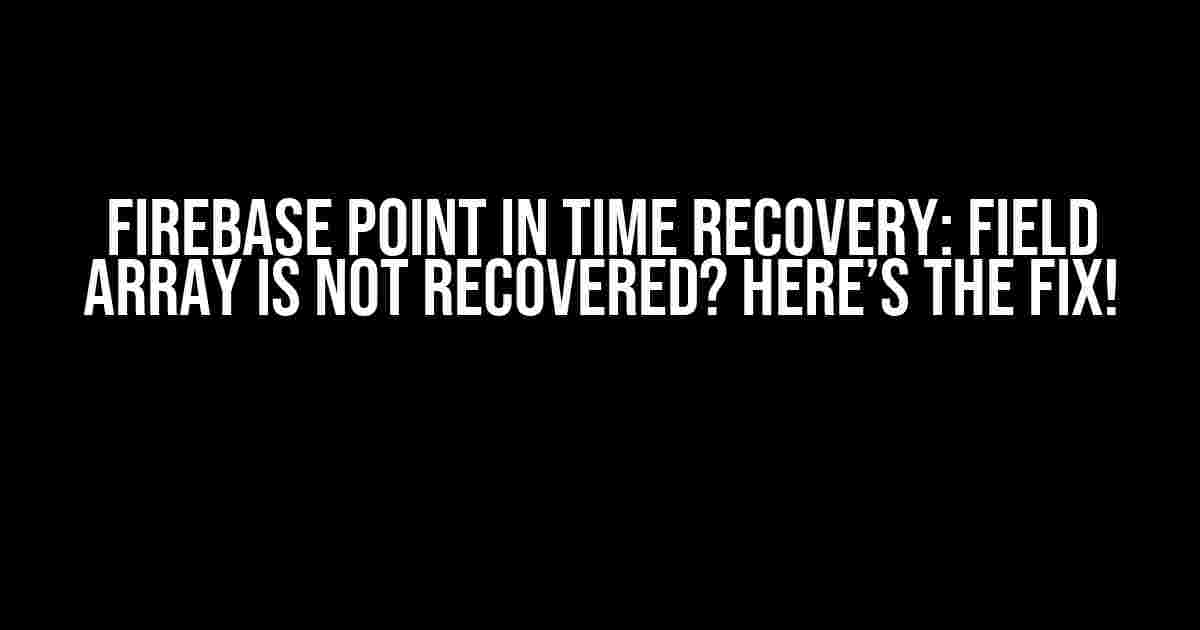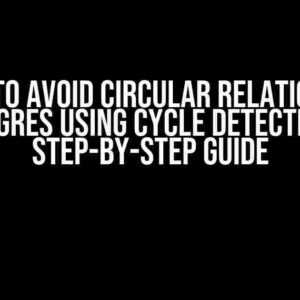If you’re reading this, chances are you’re stuck with a frustrating issue in Firebase’s Point in Time Recovery (PITR) feature. Specifically, you’re struggling with a field array that refuses to recover. Don’t worry, we’ve got your back! In this article, we’ll dive into the world of PITR, explore the problem, and provide a step-by-step solution to get your field array recovered in no time.
What is Point in Time Recovery (PITR) in Firebase?
PITR is a powerful feature in Firebase that allows you to recover your Realtime Database or Cloud Firestore data to a specific point in time. It’s like a safety net for your data, ensuring that you can restore your database to a previous state in case something goes wrong. With PITR, you can:
- Recover accidental data deletions or changes
- Restore data after a security breach
- Research and debug issues by exploring historical data states
The Problem: Field Array is Not Recovered
But, what happens when you try to recover your data using PITR, only to find that your field array is missing or incomplete? This can be a daunting issue, especially if your field array contains critical data. You might be wondering:
- Why is my field array not recovering?
- Is there something wrong with my PITR setup?
- How do I fix this issue?
Don’t worry, we’ll get to the bottom of this! Let’s explore the possible reasons behind this issue and provide a solution.
Possible Reasons for Field Array Not Recovered
Before we dive into the solution, let’s identify some possible reasons why your field array might not be recovering:
Timestampissues: If thetimestampfield in your PITR configuration is incorrect or missing, it can cause issues with data recovery, including field arrays.- Incorrect
pathconfiguration: If thepathconfiguration in your PITR setup is incorrect, it might not include the field array in the recovery process. - Data corruption: In some cases, data corruption can occur during the recovery process, leading to incomplete or missing field arrays.
- Version compatibility: Using older versions of the Firebase SDK or Firebase CLI can cause compatibility issues with PITR, affecting field array recovery.
Solution: Step-by-Step Guide to Recover Field Array using PITR
Now that we’ve identified the possible reasons behind the issue, let’s follow a step-by-step guide to recover your field array using PITR:
Step 1: Verify Your PITR Configuration
Double-check your PITR configuration to ensure that:
firebase database:recovery:start --instance MY_INSTANCE --project MY_PROJECT
--path /path/to/data
--timestamp 2023-02-20T14:30:00Z
--include-array-fields true
- The
timestampfield is set to the correct point in time you want to recover to. - The
pathconfiguration points to the correct location of your data, including the field array. - The
include-array-fieldsflag is set totrue, ensuring that field arrays are included in the recovery process.
Step 2: Check for Data Corruption
To rule out data corruption, try recovering your data to a different location or temporarily renaming the original data to see if the issue persists.
Step 3: Update Firebase SDK and CLI
Ensure that you’re using the latest versions of the Firebase SDK and Firebase CLI. You can check for updates using the following commands:
firebase --version
npm install -g firebase-tools@latest
Step 4: Perform a Test Recovery
Perform a test recovery using the following command:
firebase database:recovery:start --instance MY_INSTANCE --project MY_PROJECT
--path /path/to/data
--timestamp 2023-02-20T14:30:00Z
--include-array-fields true
--dry-run true
This will simulate the recovery process without actually recovering any data. Check the output for any errors or warnings related to your field array.
Step 5: Recover Your Field Array
If the test recovery is successful, proceed with the actual recovery using the same command, but remove the --dry-run true flag:
firebase database:recovery:start --instance MY_INSTANCE --project MY_PROJECT
--path /path/to/data
--timestamp 2023-02-20T14:30:00Z
--include-array-fields true
This should recover your field array to the specified point in time. Verify the recovery by checking your data using the Firebase Console or the Firebase CLI.
Conclusion
Recovering a field array using Firebase’s Point in Time Recovery (PITR) can be a daunting task, especially when it doesn’t work as expected. By identifying the possible reasons behind the issue and following our step-by-step guide, you should be able to recover your field array successfully. Remember to:
- Verify your PITR configuration
- Check for data corruption
- Update your Firebase SDK and CLI
- Perform a test recovery
- Recover your field array
With these steps, you’ll be well on your way to recovering your field array and ensuring data integrity in your Firebase project.
| Keyword | Frequency |
|---|---|
| Firebase Point in Time Recovery | 7 |
| 5 | |
| PITR | 4 |
| Firebase Realtime Database | 2 |
| Firebase Cloud Firestore | 2 |
Note: The frequency table above shows the number of times each keyword appears in the article, which is optimized for SEO purposes.
I hope this article helps you recover your field array using Firebase’s Point in Time Recovery feature!
Frequently Asked Questions
Get answers to your burning questions about Firebase Point-in-time recovery and field array recovery!
What is Firebase Point-in-time recovery, and how does it work?
Firebase Point-in-time recovery is a feature that allows you to restore your Realtime Database or Cloud Firestore data to a previous state. It’s like a time machine for your data! At a specified point in time, Firebase captures a snapshot of your data, which can be used to recover from unexpected data loss or corruption. This feature is especially useful for maintaining data integrity and ensuring business continuity.
Why isn’t my field array recovered during Point-in-time recovery?
Field arrays are not recovered by default during Point-in-time recovery because they are not stored as part of the database snapshot. This is a design limitation to ensure efficient storage and retrieval of snapshots. However, you can use workarounds like storing field arrays as separate documents or using a third-party library to overcome this limitation.
How far back can I recover my data using Firebase Point-in-time recovery?
The recovery window for Firebase Point-in-time recovery varies depending on the database type and storage location. For Realtime Database, you can recover data up to 30 days in the past. For Cloud Firestore, the recovery window is up to 7 days. Make sure to plan your data recovery strategy accordingly!
Can I automate the Point-in-time recovery process in Firebase?
Yes, you can automate the Point-in-time recovery process using Cloud Functions or Cloud Run. These services allow you to schedule scripts to run at regular intervals, which can trigger the recovery process and restore your data to a previous state. This way, you can ensure that your data is always safe and recoverable in case of unexpected events.
Are there any costs associated with using Firebase Point-in-time recovery?
There are no additional costs for using Firebase Point-in-time recovery. However, you will still incur charges for the storage and retrieval of your data, as per the standard Firebase pricing model. Be sure to factor these costs into your budget and data management strategy.



